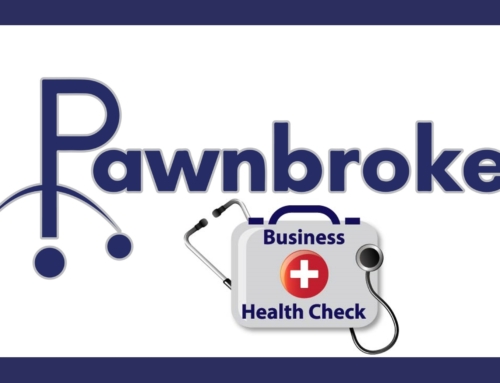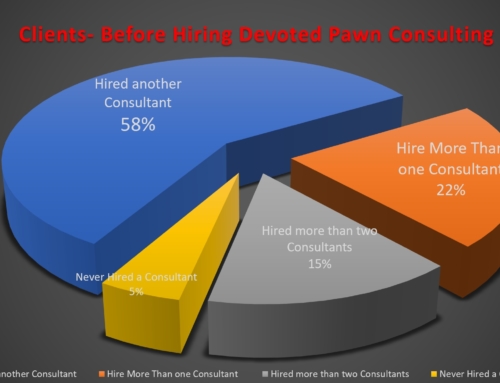You may be wondering “Why do I even need a commission structure for my team,” or “What is the perfect one for my business model”? This is something that we believe very strongly in and that we want to address here today. In fact, we even talk about this in our Pawn Health Check because we feel it is that important. If you pawnshop is using a commission plan that was created in the 80’s, 90’s or 2000’s,we guarantee it is costing you tons of money each year and we can prove it. Burt first let’s start with why do I need a commission plan in the first place.
Why Do I Need a Commission Structure in Place?
According to Forbes and many other studies, employees that receive a performance based commission produce nearly 30% more work, sales or productivity. What would your business be like if your staff produced 30% more? Sold 30% more? Here at Devoted Pawn we believe this impact to be much greater than these studies can ever show because having a commission structure that actually promotes the behavior you need the team to perform and then incentive them when they achieve the results makes the customer service experience even better. It will also lower your turnover and help you attract better talent. This is effective because your team needs to first buy into what you are trying to do, and then must be able to see what is in it for them before they perform the work that is needed to the fullest potential. What could your business look like if your employees sold more, made you more money, were more productive and your turnover was less and allowed you to attract better talent? We help our clients with this all the time and would love to discuss what your perfect commission structure looks like. Contact us for more information. This brings us to the second question, “What is the perfect commission model for my business”?
What Should My Commission Structure Be?
This question is the million-dollar question and the easiest answer that we can give is that there is no cookie cutter one size fits all model that works for every industry. There are however some proven methods that we have created that work in industries such as the Pawn & Jewelry industry, Retail sector, E-commerce, Sales, Collections, and Call centers. We would like to share what we believe are the key components of any successful compensation package.
First Steps
We believe the first step in this process is to define what key areas that you want to improve on. Generally, they are key metrics such as sales, gross profit, etc, but they can be things such as company morale and productivity as well. This is more common in factories where the work never changes and you have certain quotas during the day. An everyday example of this that we see in the pawn business is to try and increase profitability. In the past to do this, commissions structures were created that incentivized staff to sell more items (and take a percentage of the sale as commission) and to loan more money to grow the pawn balance. Sadly, this structure in many cases did more harm than good because ownership assumed this would mean more profit but mistakenly didn’t realize that it wasn’t tied to profit at all. All this makes your team do is loan more money on items to make a quota and then when you sell it, your profit margin is less. On top of it you are paying a commission to do it (making less profit). Unfortunately, this is still very much in use with many of the pawn shops and chains that we talk to every day. In this case the focus was on the wrong behavior used to make the business more profitable and actually hurt it because more sales happened at a discounted rate resulting in less profit. More money went out on loans that won’t translate into profitable sales, which brings us to point number two.
Once you have CLEARLY defined what things you want to focus on for commission (such as more profitability), you must then perfectly define the behavior that needs to happen that will allow for that result. If in the example above, they were clear on the way the staff was to grow the loan balance with profitable only loans and didn’t turn away good customers, and that the sales had to make X amount of profit before the commission counted, the results, although still not perfect, would have been much better. What would be perfect is to look at ALL things that affect the profitability of the location and then make the commission structure accordingly. In the example above, you need to look not only at gross profit on the item as it sells, but redemption ratio, layaways, pawn interest, overdue layaways (realizing that items on the shelf cost you profit because they can’t be sold, and unless they are gold, depreciate with time), and overdue pawn interest (because the interest should be collected or the item pulled when it is able to be. Doing neither costs you money because of the dreaded depreciation again, especially with electronics), just to name a few. Once you have perfectly defined the items and the training and behavior needed to fix the issues you can move on to step three.
Step three is as simple as defining what the pay out should be in the form of commission for the job done. Easy, right? This is actually the second failing point for most bonus or commission plans. If you just commission a dollar amount on the sale item, you don’t correct the entire behavior needed to ultimate success. And what that dollar amount even should be. Then comes the complexity. What if one person does sales only? Should they be penalized because they can’t sell items at a profit because the pawnbrokers keep paying too much for everything? What if your staff doesn’t ever position in the process (sales, pawn broking etc.) but one bad apple keeps messing up the situation? These are the last things that need to be ironed out and because of the complexity, we recommend getting some help in this area.
In summary, we feel the “perfect commission structure” will be slightly different in every company depending on your situation but should have in common these three major things:
- The commission should define what key things need to change or improve (such as profits, morale productivity, etc.) The behavior drives the results and the results drive the commission.
- The commission plan needs to clearly and perfectly define the behavior change necessary, the training that needs to happen and the documented desired results. Then and only then will you have buy in and accountability from your staff.
- The payout must only be when the results are clearly achieved. For example, the commission can only be paid when profits of X are achieved. This allows the team member to see “what is in it for me” and will make this whole process work.
We have done this for countless businesses and not just in the pawn industry. If you want to know more about how we can help you in any way in this endeavor, please contact us or call 727-580-5876.




